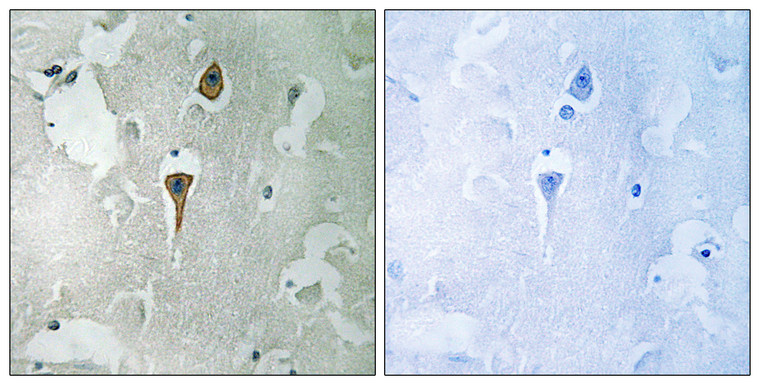| Host: |
Rabbit |
| Applications: |
WB/IHC/IF/ELISA |
| Reactivity: |
Human/Mouse/Rat |
| Note: |
STRICTLY FOR FURTHER SCIENTIFIC RESEARCH USE ONLY (RUO). MUST NOT TO BE USED IN DIAGNOSTIC OR THERAPEUTIC APPLICATIONS. |
| Short Description: |
Rabbit polyclonal antibody anti-Glutamate receptor ionotropic, NMDA 1 (856-905) is suitable for use in Western Blot, Immunohistochemistry, Immunofluorescence and ELISA research applications. |
| Clonality: |
Polyclonal |
| Conjugation: |
Unconjugated |
| Isotype: |
IgG |
| Formulation: |
Liquid in PBS containing 50% Glycerol, 0.5% BSA and 0.02% Sodium Azide. |
| Purification: |
The antibody was affinity-purified from rabbit antiserum by affinity-chromatography using epitope-specific immunogen. |
| Concentration: |
1 mg/mL |
| Dilution Range: |
WB 1:500-1:2000IHC 1:100-1:300IF 1:200-1:1000ELISA 1:5000 |
| Storage Instruction: |
Store at-20°C for up to 1 year from the date of receipt, and avoid repeat freeze-thaw cycles. |
| Gene Symbol: |
GRIN1 |
| Gene ID: |
2902 |
| Uniprot ID: |
NMDZ1_HUMAN |
| Immunogen Region: |
856-905 |
| Specificity: |
NMDA Zeta 1 Polyclonal Antibody detects endogenous levels of NMDA Zeta 1 protein. |
| Immunogen: |
The antiserum was produced against synthesized peptide derived from human NMDAR1. AA range:856-905 |
| Post Translational Modifications | NMDA is probably regulated by C-terminal phosphorylation of an isoform of NR1 by PKC. Dephosphorylated on Ser-897 probably by protein phosphatase 2A (PPP2CB). Its phosphorylated state is influenced by the formation of the NMDAR-PPP2CB complex and the NMDAR channel activity. |
| Function | Component of NMDA receptor complexes that function as heterotetrameric, ligand-gated ion channels with high calcium permeability and voltage-dependent sensitivity to magnesium. Channel activation requires binding of the neurotransmitter glutamate to the epsilon subunit, glycine binding to the zeta subunit, plus membrane depolarization to eliminate channel inhibition by Mg(2+). Sensitivity to glutamate and channel kinetics depend on the subunit composition. |
| Protein Name | Glutamate Receptor Ionotropic - Nmda 1Glun1Glutamate Nmda Receptor Subunit Zeta-1N-Methyl-D-Aspartate Receptor Subunit Nr1Nmd-R1 |
| Database Links | Reactome: R-HSA-3928662Reactome: R-HSA-438066Reactome: R-HSA-442982Reactome: R-HSA-5673001Reactome: R-HSA-6794361Reactome: R-HSA-8849932Reactome: R-HSA-9609736Reactome: R-HSA-9617324Reactome: R-HSA-9620244 |
| Cellular Localisation | Cell MembraneMulti-Pass Membrane ProteinPostsynaptic Cell MembranePostsynaptic DensityEnriched In Postsynaptic Plasma Membrane And Postsynaptic Densities |
| Alternative Antibody Names | Anti-Glutamate Receptor Ionotropic - Nmda 1 antibodyAnti-Glun1 antibodyAnti-Glutamate Nmda Receptor Subunit Zeta-1 antibodyAnti-N-Methyl-D-Aspartate Receptor Subunit Nr1 antibodyAnti-Nmd-R1 antibodyAnti-GRIN1 antibodyAnti-NMDAR1 antibody |
Information sourced from Uniprot.org
12 months for antibodies. 6 months for ELISA Kits. Please see website T&Cs for further guidance









